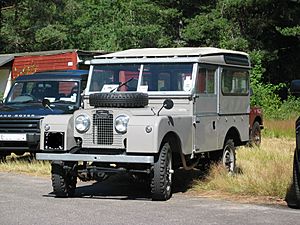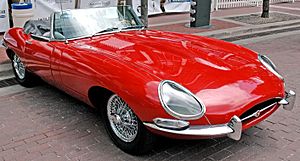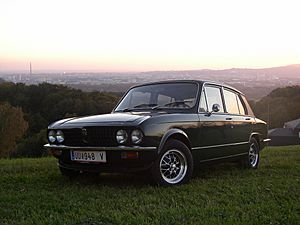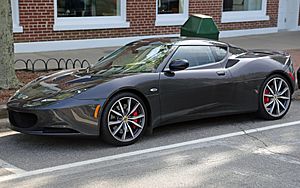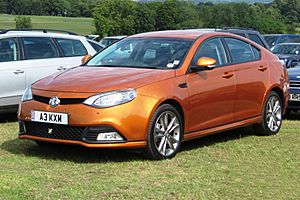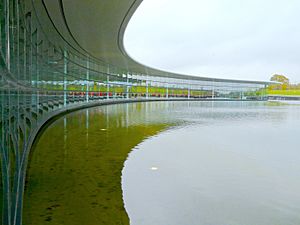Automotive industry in the United Kingdom facts for kids
The automotive industry in the United Kingdom is famous for making awesome premium and sports cars! Think of cool brands like Aston Martin, Bentley, Jaguar, Land Rover, Lotus, McLaren, Mini, and Rolls-Royce.
Big car makers like Nissan, Toyota, and Vauxhall Motors also have a huge presence here. Plus, companies like Alexander Dennis and Leyland Trucks make commercial vehicles (like buses and lorries).
In 2018, the UK car industry made a massive £82 billion! It added £18.6 billion to the UK economy and produced about 1.5 million passenger cars and 85,000 commercial vehicles. Around 168,000 people worked directly in car manufacturing, with many more in related jobs like selling and servicing cars.
The UK is also a major hub for making engines, with about 2.71 million engines produced in 2018. And guess what? The UK is a big deal in auto racing! The UK motorsport industry employs about 38,500 people and makes around £6 billion a year.
The British car industry started way back in the late 1800s. By the 1950s, the UK was the second-biggest car maker in the world (after the USA) and exported the most cars! However, over the years, other countries like France, Germany, and Japan grew faster. By 2008, the UK was the 12th largest car producer.
Since the 1990s, many famous British car brands have been bought by companies from other countries. For example, BMW owns Mini and Rolls-Royce, Tata owns Jaguar and Land Rover, and Volkswagen Group owns Bentley.
Some of the most famous British cars ever include the Aston Martin DB5, Jaguar E-Type, Land Rover Defender, McLaren F1, and the original two-door Mini. Many talented designers like Alec Issigonis (who designed the Mini!) and Gordon Murray have also come from the UK.
Contents
History of UK Cars
The Very Beginning (1896-1900)
Cars first appeared on British roads in the early 1890s, but they were all imported from other countries. The British car industry really began in the late 1880s. A London engineer named Frederick Simms became friends with Gottlieb Daimler, who had invented a great petrol engine. Simms bought the rights to Daimler's engine for Britain.
In 1895, Simms and his friend Evelyn Ellis showed off motor cars in the UK. They drove a Daimler-engined car from Southampton to Malvern, which was the first long-distance car journey in Britain!
Soon after, a company called The Daimler Motor Company Limited was formed in 1896. They bought an old cotton mill in Coventry to start making car engines and parts. Many people say this is where the UK's first mass-produced car was made.
It's a bit of a debate about which was the first all-British car. George Lanchester's early cars in 1895 and 1896 used some French and German parts. However, Richard Stephens from South Wales made a car in 1897 that was almost entirely his own design, including the engine! He even set up a small production line and made twelve vehicles.
Early car development in the UK was slowed down by old laws called Locomotive Acts. These laws made it really hard to use cars on public roads, like needing three people to operate a vehicle and a super slow speed limit of 2 miles per hour in towns! Luckily, these rules were changed in 1896, allowing cars to go up to 14 miles per hour. To celebrate, people held the Emancipation Run, which is still remembered today with the annual London to Brighton Veteran Car Run.
Growing Up (1900-1939)
At first, British cars copied ideas from Germany and France. But by 1900, Herbert Austin designed and built the first all-British 4-wheel car. In 1901, he started Wolseley Motors in Birmingham, which became the UK's biggest car maker until Ford took over in 1913.
Many early car companies struggled. Out of 200 British car brands launched by 1913, only about 100 were still around. In 1913, Ford was the top UK carmaker, building 7,310 cars.
Car production almost stopped during World War I (1914-1918), as factories switched to making military vehicles. But the war also led to new ways of mass-producing things in the car industry.
By 1929, only 58 car companies were left in the UK. Production was mostly controlled by Morris (started by William Morris in 1910) and Austin (started by Herbert Austin in 1905). Together, they made about 60% of all UK cars!
In 1932, the UK became Europe's largest car producer, a title it held until 1955. By 1939, the top car makers were Morris, Austin, Ford, Standard, Rootes, and Vauxhall.
After the Wars (1939-1955)
During World War II, UK car factories made military vehicles and aircraft engines instead of cars. After the war, the government wanted companies to export (sell to other countries) a lot of their products to help the economy. This meant British car exports reached record levels, and the UK became the world's biggest car exporter! In 1950, 75% of British cars and 60% of commercial vehicles were exported.
This lasted until the mid-1950s when other countries' car industries recovered. By 1952, American-owned companies like Ford and Vauxhall had a big share of the British market. This led to a huge merger in 1952: Morris and Austin joined to form the British Motor Corporation (BMC). BMC then made cars under brands like Austin, Morris, MG, Riley, and Wolseley, controlling 40% of the British market. But by 1956, Germany had overtaken the UK in car production.
The Mini Era (1955-1968)
By 1955, five companies made 90% of the UK's cars: BMC, Ford, Rootes, Standard-Triumph, and Vauxhall. Brands like Rover and Jaguar were known for their special, high-quality cars. By 1960, the UK had fallen to third place in world car production.
British car companies often made many different models, which made it harder to lower costs. BMC, for example, kept making cars under many different brand names, even if they competed with each other.
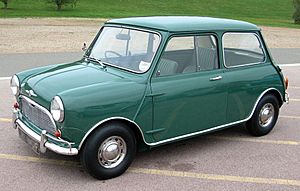
In 1968, the government helped merge two big British car groups, Leyland-Triumph-Rover and BMH, to create the British Leyland Motor Corporation (BLMC). This new company planned to invest in new cars and modern factories.
The Mini, designed by Alec Issigonis, changed the small car market when it launched in 1959. It was one of the UK's best-selling cars for over 20 years, with the last one made in 2000! Another popular car was the Morris Minor, known for being cheap to run and reliable. It was the first British car to sell over a million units by 1961.
Other popular British cars in the 1960s included the Ford Cortina, Austin/Morris 1100/1300, and the Vauxhall Victor. The amazing Jaguar E-Type sports car, launched in 1961, could go up to 145 mph! Cheaper sports cars like the MG B and Triumph Spitfire were also very popular.
Foreign cars slowly started to become more popular in the UK during the 1960s. The Volkswagen Beetle from West Germany, though initially disliked after the war, became very popular. French cars like the Renault 4 and the Renault 16 (the world's first production hatchback!) also gained fans. Japanese cars like Daihatsu and Toyota also started to appear, setting the stage for their huge popularity later on.
Challenges and Changes (1968-1987)
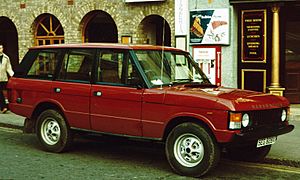
By 1968, four main companies dominated UK car production: BLMC, Chrysler (UK), Ford, and Vauxhall (GM). British Leyland (BLMC) faced many problems, including internal disagreements, unpopular new cars like the Austin Allegro and Morris Marina, worker strikes, and quality issues. Even though their cars sold well in Britain, they weren't as popular overseas.
Japanese cars, especially those from Nissan (sold as Datsun), became very popular in the 1970s because they were affordable, cheap to run, and reliable. French cars like the Renault 5 and German cars like the Volkswagen Golf also gained popularity.
Many foreign car makers started using the "hatchback" design (where the back opens like a door) and front-wheel drive earlier than British companies. For example, the Volkswagen Golf hatchback came out in 1974, four years before any British car maker had a similar car.
By 1974, the UK had dropped to sixth place in world car manufacturing. Both BLMC and Chrysler UK needed financial help from the government. In 1975, BLMC was effectively taken over by the government and renamed British Leyland (BL). Chrysler sold its European businesses, including those in the UK, to Peugeot in 1978. These became known as Peugeot-Talbot.
The 1970s saw big changes in car design. Front-wheel drive and hatchback cars became common. Many Ford and Vauxhall cars were also being made in factories in other European countries.

By the end of the 1970s, Ford, Peugeot-Talbot, and Vauxhall were closely linked with their parent companies' European operations. BL, however, was mostly a UK-based company. To improve things, BL cut jobs and closed some factories, which hit cities like Coventry hard.
In 1979, BL started working with Honda to develop new cars, like the Triumph Acclaim and later the Rover 200 Series. The government continued to support BL, helping to develop new models like the Austin Metro, Austin Maestro, and Austin Montego. The Metro was the most successful of these. In 1986, BL was renamed the Rover Group.
The 1980s also saw the rise of "hot hatchbacks" (fast versions of hatchback cars), which made sports cars less popular for a while. Many old British car brands like MG, Triumph, and Morris were stopped, with their cars later sold under the Austin or Rover names.
Vauxhall's cars became more popular in the 1980s. They launched the Vauxhall Astra in 1980 and the MK2 Cavalier in 1981, which became their best-selling car of the decade.
New Ownership (1987-2001)

In 1986, Nissan became the first Japanese carmaker to open a factory in Europe, in Sunderland, UK. They made cars like the Nissan Bluebird and Nissan Primera, and later the Nissan Micra. Toyota also opened a new plant in Burnaston near Derby in 1992.
Peugeot started making cars like the Peugeot 309 and Peugeot 405 at its Ryton factory (an old Rootes Group factory) in the UK. Later, they also made the Peugeot 306 and Peugeot 206 there.
Honda's partnership with Rover Group ended in 1994 when British Aerospace sold Rover Group to the German carmaker BMW for £800 million. This meant that for the first time in over 100 years, the UK didn't have a major British-owned car maker. BMW helped Rover develop newer, more luxurious models and even brought back the MG sports car with the MGF in 1995.
However, in 2000, BMW decided to break up the Rover Group. They kept the Mini brand, sold Land Rover to Ford, and sold the MG and Rover brands to a group called the Phoenix Consortium, who renamed the company MG Rover. Honda continued to make its Civic cars in the UK at its Swindon plant.
Ford bought Aston Martin in 1987 and Jaguar in 1989. By the end of the century, Ford also owned Land Rover.
In 1998, Vickers plc sold Rolls-Royce Motors. The Volkswagen Group won the auction, but the rights to the Rolls-Royce name were eventually sold to BMW, who took full control in 2003.
The 1990s also saw a comeback for affordable sports cars, thanks to the popular Japanese Mazda MX-5. Rover launched the MG F in 1995, and the Lotus Elise also sold well.
Recent Times (2001-Present)
In 2002, Ford stopped making passenger cars at its Dagenham plant, ending 90 years of car assembly there. However, they invested a lot of money to make it a huge diesel engine factory.
Vauxhall's Luton car assembly plant closed in 2003, leaving Ellesmere Port as their only car assembly plant in the UK.
Losses at Jaguar led to the closure of their Browns Lane plant in Coventry in 2004.
MG Rover faced financial trouble and went out of business in 2005, leading to over 6,000 job losses. Later, a Chinese carmaker, Nanjing Automobile, bought its assets, and production of the MG TF restarted at Longbridge in 2007.
In 2006, Peugeot closed its Ryton plant. In 2007, Ford sold Aston Martin. In 2008, Ford sold Jaguar Land Rover to Tata Motors of India for £1.15 billion.
In 2010, McLaren Automotive revealed plans to make about 4,000 cars a year at its Woking factory. Lotus Cars also announced big plans to invest and increase production at its Hethel factory.
In 2011, BMW announced new Mini models. Jaguar Land Rover hired more staff and signed big contracts with UK companies to make its new Range Rover Evoque. MG Motor (owned by SAIC Motor) restarted mass production at the Longbridge plant, making the first MG 6 in the UK.
In 2011, Nissan announced that its new Qashqai model would be designed and built in the UK, creating many jobs. BMW also invested £500 million in the UK to expand the Mini range. Jaguar Land Rover confirmed a £355 million investment to build a new engine plant near Wolverhampton.
In 2013, a new National Automotive Innovation Campus was planned at the University of Warwick to boost car innovation.
In 2014, the UK had its best year for new car sales in nine years, with over 1.5 million cars produced. However, in 2019, new car registrations went down for the third year in a row. The best-selling cars in the UK in 2019 were the Ford Fiesta, Volkswagen Golf, and Ford Focus.
In 2019, Honda announced that its Swindon plant would close by 2021. But in 2021, Aston Martin announced that its electric sports cars would be made at its plant in Gaydon, Warwickshire.
Where Cars are Made (Assembly Plants)
The UK has many car factories where different types of vehicles are put together. Here are some of the main ones:
| Company | Parent company | Parent headquarters | Plant | Models produced | Production (latest figures) |
|---|---|---|---|---|---|
| Aston Martin Lagonda | Aston Martin Lagonda | United Kingdom | Gaydon, St Athan | DBS, Vantage, DB11, Valkyrie, DBX | 6,200 (2022) |
| Bentley Motors | Volkswagen Group | Germany | Crewe | Azure, Brooklands Coupé, Continental Flying Spur, Continental GT, Mulsanne | 5,174 (2022) |
| GM Manufacturing Luton | Adam Opel AG | Germany | Luton | Opel/Vauxhall Vivaro, Renault Trafic, Nissan Primastar | 77,836 |
| Jaguar Land Rover | Tata Motors | India | Castle Bromwich | XF, XJ, XK, F-Type | 54,030 (includes Halewood production) |
| Jaguar Land Rover | Tata Motors | India | Halewood | Land Rover Discovery Sport, Range Rover Evoque | see JLR Castle Bromwich and Solihull |
| Jaguar Land Rover | Tata Motors | India | Solihull | Defender, Discovery 4, Range Rover Sport, Range Rover | 234,647(Includes Halewood production) |
| Leyland Trucks | Paccar | United States | Leyland | DAF CF, DAF LF, DAF XF | 17,478 |
| LEVC | Geely | China | Coventry | TX | 2,508 (2022) |
| Lotus Cars | Geely | China | Hethel | Elise, Exige, Evora | 1,710 (2021) |
| McLaren Automotive | McLaren Group | United Kingdom | Woking | MP4-12C, P1, P1 GTR, 570S, 650S, 675LT, 540C, 570GT | 1,598 (2021) |
| Mini | BMW | Germany | Plant Oxford | Clubman, Convertible, Coupé, Roadster, Hardtop/Hatch | 210,973 (2016) |
| Nissan UK | Nissan Motor Company | Japan | Sunderland | Juke, Leaf, Note, Qashqai | 507,444 (2016) |
| Rolls-Royce Motor Cars | BMW | Germany | Goodwood | Ghost, Phantom, Phantom Coupé, Phantom Drophead Coupé | 3,538 |
| Toyota Manufacturing UK | Toyota Motor Corporation | Japan | Burnaston | Corolla, Suzuki Swace | |
| Vauxhall Motors | Adam Opel AG | Germany | Ellesmere Port | Opel Astra/Vauxhall Astra | 118,112 (2016) |
There are also many smaller companies that make a few special cars, like David Brown Automotive and Lister Cars.
Car Design in the UK
The UK is a strong place for car design and technology. Many foreign car companies have their research and development centers here, including:
- Ford Dunton Technical Centre, Essex
- Jaguar Land Rover Technical Centre, Gaydon
- Jaguar Land Rover HQ and Design Centre, Whitley
- General Motors Millbrook Proving Ground, Bedfordshire
- Nissan Design Europe, London
- Nissan Technical Centre Europe, Cranfield
- SAIC Motor UK Technical Centre, Birmingham
There are also independent designers and design companies like Gordon Murray Design.
Motorsport in the UK
It's thought that about 4,000 companies in the UK are involved in making things for motorsport.
Formula One racing is very popular in the UK. Many of the top Formula One teams have their main bases or European headquarters in England:
- Haas F1 Team, Banbury
- McLaren – Woking
- Mercedes AMG Formula One Team – Brackley
- Aston Martin – Silverstone
- Red Bull Racing – Milton Keynes
- Alpine F1 Team – Enstone
- Williams Grand Prix Engineering – Grove
Some Formula One engine suppliers are also based here, like Cosworth and Mercedes AMG High Performance Powertrains.
Old Car Brands (Inactive Marques)
Many British car brands that used to make cars are no longer active. Some of these include:
- Austin
- Daimler
- Hillman
- Humber
- Morris
- Riley
- Rover
- Standard
- Triumph
- TVR
- Wolseley Motors
Car Dealerships
There are many large groups of car dealerships in the UK. As of 2021, Sytner Group was the biggest.
- Arnold Clark Automobiles
- Ford Retail Group
- Group 1 Automotive (a US-owned group)
- Inchcape plc
- Jardine Motors Group (part of a Hong Kong company)
- JCT600
- Listers Group
- Lookers
- H.R. Owen
- Pendragon plc
- Perrys Motor Sales
- Robins & Day (owned by Peugeot Citroën)
- Stoneacre Motor Group
- Sytner Group (owned by a US company, Penske Corporation)
- Vertu Motors
- Wessex Garages
- Chapelhouse Motor Group
- Marshall Motor Group
UK Car Market
Even though many British car brands are now owned by foreign companies, cars made in the UK are still very popular here. For example, the Nissan Qashqai sells really well.
In 2014, 2.45 million cars were sold in the UK. The Volkswagen Group (which owns brands like VW, Audi, Skoda) had the biggest share of sales, followed by Ford Motor Company and General Motors. Smaller cars were the most popular, but SUVs (Sport Utility Vehicles) were also becoming very common.
In 2019, the best-selling car models in the UK were the Ford Fiesta, Volkswagen Golf, and Ford Focus.
See Also
- List of automobile manufacturers
- The Society of Motor Manufacturers and Traders
- List of car manufacturers of the United Kingdom
Images for kids
-
Vauxhall Ellesmere Port, a Vauxhall Motors factory.
-
The GM Manufacturing Luton plant in Luton.
-
Plant Oxford in Cowley, Oxford, where the Mini cars are made.






